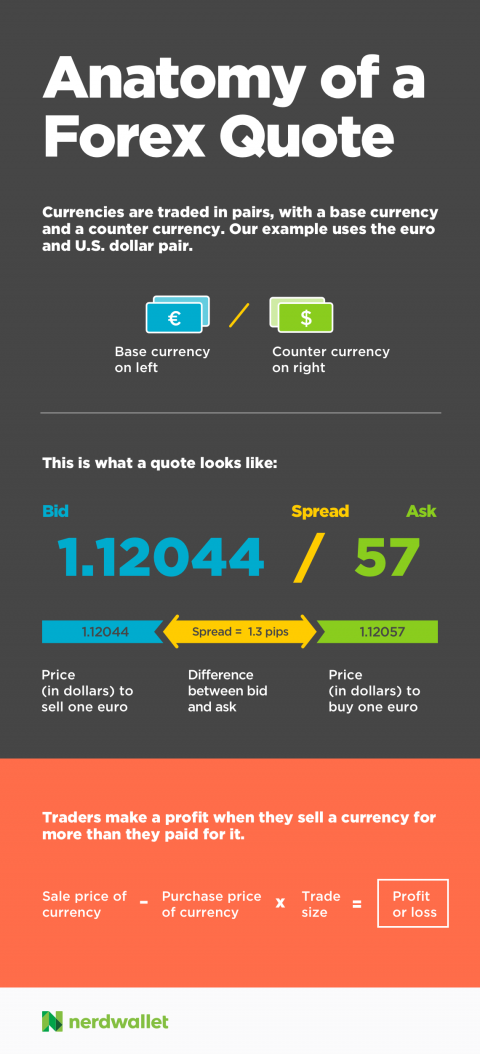Forex Trading for Beginners
Forex trading can be complicated and risky, but it can also be lucrative without requiring a large initial investment.

Many, or all, of the products featured on this page are from our advertising partners who compensate us when you take certain actions on our website or click to take an action on their website. However, this does not influence our evaluations. Our opinions are our own. Here is a list of our partners and here's how we make money.
The investing information provided on this page is for educational purposes only. NerdWallet, Inc. does not offer advisory or brokerage services, nor does it recommend or advise investors to buy or sell particular stocks, securities or other investments.
Forex trading refers to buying and selling currencies from around the globe.
For example, if you think the Euro will rise and the U.S. dollar will fall, you could buy Euros and sell U.S. dollars.
Forex trading is fairly risky and likely isn't suitable for beginner investors.
If you’ve ever traveled internationally, you’ve touched on the world of forex trading, though you may not know it: When you stepped off the airplane, one of your first stops probably was to exchange your money for the local currency.
NerdWallet rating 4.8 /5 | NerdWallet rating 4.6 /5 | NerdWallet rating 4.5 /5 |
Fees $0 per online equity trade | Fees $0 | Fees $0 per trade |
Account minimum $0 | Account minimum $0 | Account minimum $0 |
Promotion None no promotion available at this time | Promotion Earn up to $10,000 when you transfer your investment portfolio to Public. | Promotion Get up to $700 when you open and fund a J.P. Morgan Self-Directed Investing account with qualifying new money. |
What is forex trading?
Forex — or FX — refers to the foreign exchange market, and forex trading is the process of buying and selling currencies from around the globe. The forex market is the largest financial market in the world, but one in which many individual investors have never dabbled, in part because it’s highly speculative and complex.
» Dive deeper into international stocks
A little healthy trepidation serves investors well. Active trading strategies and complex investment products don’t have a place in most portfolios. Financial advisors often strongly recommend low-cost index funds for long-term goals like saving for retirement.
But maybe you have a balanced portfolio in place, and now you’re looking for an adventure with some extra cash. Provided you know what you’re doing — please take those words to heart — forex trading can be lucrative, and it requires a limited initial investment.
» Already know the basics? Here are the best brokers for forex trading
Understanding forex trading
The concept of trading forex can be hard to wrap your head around. Here's how it works: Currencies are always traded in pairs, such as the Euro and the U.S. dollar. When you trade forex, you always buy one currency and sell another (which is why currencies are also always quoted in pairs).
Currencies rise and fall at different rates (for example, the Euro may rise while the U.S. dollar falls) based on geopolitical or economic factors such as natural disasters or elections. Based on those kinds of factors, you might think that a related currency — for example, the Euro — will rise in value. You could then buy Euros and sell U.S. dollars. If your prediction panned out, and the Euro did rise in value, you would make a profit. Of course, there are many more nuances that make forex trading complex, which we'll get into below.
» More on global investing: How to get exposure to emerging markets
Current forex trading rates
The chart below shows two paired currencies and reflects what one unit of the first listed currency is worth in the second listed currency. For example, the first row shows how much one Euro is worth in U.S. dollars.
Forex trading quotes are pulled from Google Finance and may be delayed up to 20 minutes. Data is solely for informational purposes, not for trading purposes.
How to read a forex quote
Being able to read and really understand a forex quote is, unsurprisingly, key to trading forex. Let’s start with an example of an exchange rate: EUR/USD 1.12044.
The currency on the left (EUR) is the base currency and is always equal to one unit — 1€, in this example.
The currency on the right (USD) is called the counter or quote currency.
The number is what the counter currency is worth relative to one unit of the base currency. When that number goes up, it means the base currency has risen in value, because one unit can buy more of the counter currency. When that number goes down, the base currency has fallen. In this example quote, 1€ is equal to $1.12044.
You're always buying or selling the base currency. Within a pair, one currency will always be the base and one will always be the counter — so, when traded with the USD, the EUR is always the base currency. When you want to buy EUR and sell USD, you would buy the EUR/USD pair. When you want to buy USD and sell EUR, you would sell the EUR/USD pair.

Bid and ask prices
As with stock trading, the bid and ask prices are key to a currency quote. They, too, are tied to the base currency, and they get a bit confusing because they represent the dealer's position, not yours. The bid price is the price at which you can sell the base currency — in other words, the price the dealer will “bid,” or pay, for it. The ask price is the price at which you can buy the base currency — the price at which the dealer will sell it, or “ask” for it.
The ask price tells you how much of the counter currency (USD, in our example) it will take to buy one unit of the base currency (EUR).
The bid price tells you how much of the counter currency you can buy when you sell one unit of the base currency.
The difference between these two prices — the ask price minus the bid price — is called the spread.
The bid and ask are typically shown as EUR/USD bid/ask, and the ask is represented with only the last two digits. For example, EUR/USD 1.12044/57 means that the bid is 1.12044 and the ask is 1.12057. You could sell 1€ for $1.12044 (the bid) and buy 1€ for $1.12057 (the ask).
The bid price is always lower than the ask price, and the tighter the spread, the better for the investor. Many brokers mark up, or widen, the spread by raising the ask price. They then pocket the extra rather than charging a set trade commission.
The last salient point about pricing is that the spread, earnings and losses are measured in a unit called a pip.
What is a pip?
Remember when we said forex trading was complex? We weren’t lying. In stock trading, you might hear or read that a stock's share price went up a point, or $1. A pip is the forex version of a point: the smallest price movement within a currency pair.
A pip’s value depends on the trade lot and the currency pair. If you’re trading a pair that has the USD as the counter currency and you’re using a dollar-based account to buy and sell, the pip values are:
Micro lot (1,000 units): pip = 10 cents.
Mini lot (10,000 units): pip = $1.
Standard lot (100,000 units): pip = $10.
If the USD is the base currency, the pip value will be based on the counter currency, and you’ll need to divide these values for micro, mini and standard lots by the pair’s exchange rate.
To figure out how many pips are in the spread, subtract the bid price from the ask price: That gives you 0.00013 in our EUR/USD example. For most pairs, the smallest price movement happens in the fourth digit after the decimal, so the spread here is 1.3 pips, or $1.30 on a mini lot. That’s the cost of the trade.
» Explore other alternative investments
Understanding forex lot sizes
Forex is traded by the “lot.” A micro lot is 1,000 units of currency, a mini lot is 10,000 units, and a standard lot is 100,000 units. The larger the lot size, the more risk you’re taking on; individual investors should rarely trade standard lots. If you’re a beginner, we recommend sticking to micro lots while you get your footing.
This seems like a good place to note that reputable forex brokers often give investors access to a demo trading account. It’s much more fun to lose play money than real money, especially while you’re learning the ropes.
How to make money trading forex
As noted at the start of this post, forex trading is risky. You’re making a bet that what you buy will go up in value. With forex, you want the currency you're buying to go up relative to the currency you're selling. If you bought a mini lot of a currency and it goes up 1 pip in value, your investment would be worth $1 more. If it goes down 1 pip, your investment would be worth $1 less.
That’s easy enough to understand — after all, whether you’re buying a house or the euro, you want what you buy to be worth more than you paid for it. Where things get hairy is that leverage mentioned earlier.
Using your leverage
Leverage allows you to borrow money from the broker to trade more than your account value. Many brokers offer leverage of up to 50:1 on major pairs, which means you can initiate trades up to 50 times larger than the balance in your account.
Let’s go back to our earlier example. Let's say you want to buy EUR/USD at 1.12044/57. To trade a mini lot, or 10,000 units, you'd need to pay $11,205.70 for 10,000 euros. You might not want to put up that much on one trade, so you'd use leverage to enter the position with a smaller amount:
10:1 leverage would require $1,120.57 from your account (one-tenth of the trade value).
20:1 leverage would require $560.29 (one-twentieth of the trade value).
50:1 leverage would require $224.11 (one-fiftieth of the trade value).
The upside? Because currency movements typically are small but frequent — often under 100 pips a day — leverage allows you to buy more with less cash upfront, increasing your return if the currency you’re buying goes up.
The downside, you may have guessed, is that leverage also increases your losses if the currency you’re buying goes down. The more leveraged your account and the larger the lot size you’re trading, the more exposed you are to a wipeout.
Forex trading vs. stock trading
Trading forex is different from stock trading in several ways:
Forex trades are made over the counter — trader to trader or through forex brokers or dealers — rather than through a central exchange.
Because traders work across time zones, the forex market is open 24 hours a day, five days a week.
Currency prices fluctuate rapidly but in small increments, which makes it hard for investors to make money on small trades. That’s why currencies almost always are traded with leverage, or money borrowed from the broker.




